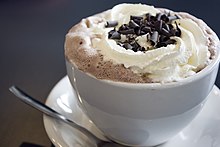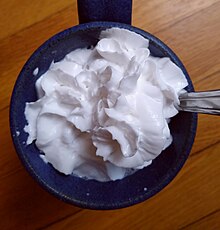Whipped cream is heavy, double, or other high-fat dairy cream that is whipped by a whisk or mixer until it is light and fluffy and holds its shape. Cream aerated by the expansion of dissolved gas, forming a firm colloid, is also called whipped cream. It is often sweetened, typically with white sugar, and sometimes flavored with vanilla. Whipped cream is also called Chantilly cream or crème Chantilly (French: [kʁɛm ʃɑ̃tiji]).
 A cup of hot chocolate topped with whipped cream from a pressurized can | |
| Type | Cream |
|---|---|
| Main ingredients | Cream |
| Variations | Added sugar and other flavorings, such as vanilla |

Fat content
Cream with high butterfat content—typically 30%–36%—is used for whipping, as fat globules contribute to forming stable air bubbles.[1]
During whipping, partially coalesced fat molecules create a stabilized network that traps air bubbles.[2] The resulting colloid has about twice the volume of the original cream. If whipping is prolonged further, the fat droplets stick together, destroying the colloid and forming butter. Low-fat cream, or milk, does not have enough fat to whip effectively.[3]
Production
Cream is usually whipped with a whisk, an electric hand mixer, or a food processor. Results are best when the equipment and ingredients are chilled.[4] The bubbles in the whipped cream immediately start to pop, and it begins to liquefy, giving it a useful lifetime of one to two hours. Many 19th-century recipes recommend adding gum tragacanth to stabilize whipped cream, while a few include whipped egg whites.[5] Various other substances, including gelatin and diphosphate, are used in commercial stabilizers.[6][7][8][9]
Instant
Cream aerated by an aerosol can or by a whipping siphon with a whipped-cream charger is sometimes described as whipped cream; it is similar to cream that has been aerated by whipping. A gas dissolves in the butterfat under pressure; when the pressure is released, the gas comes out of solution, forming small bubbles "aerating" the mass. Nitrous oxide gas is usually used; while carbon dioxide produces the same physical effect, it gives a sour taste.[10] Cream supplied in an aerosol can is also known as skooshy cream (Scottish), squirty cream, spray cream,[11] or aerosol cream.[12][13] There are many brands of aerosol cream, with varying sweeteners and other factors.[14]
In some jurisdictions, sales of canned whipped cream are limited to avoid potentially dangerous nitrous oxide abuse.[15]
Flavorings
Whipped cream can be flavored with sugar, vanilla, coffee, chocolate, orange, or other flavorings.[16]
History
Les mousses se font avec de la crême bien douce & peu épaisse; on la fouette, ce qui la fait mousser, & c'est de cette mousse qu'on fait usage: on peut lui donner tel goût que l'on veut, aromates, fleurs, fruits, vins, ou liqueurs.
Mousses are made with sweet cream, not very thick; one whips it, which makes it foam, and it is this foam that one uses: one may give it whatever flavor one wants, with aromatics, flowers, fruits, wines, or liqueurs.
M. Emy, 1768[17]
Whipped cream, often sweetened and aromatised, was popular in the 16th century,[18] with recipes in the writings of Rabelais[19] (Paris, 1531), unknown author in A Proper Newe Booke of Cokerye[20] (London, 1545), Cristoforo di Messisbugo (Ferrara, 1549),[21] Bartolomeo Scappi (Rome, 1570),[18] and Lancelot de Casteau (Liège, 1604).[22] It was called milk or cream snow (neve di latte, neige de lait, neige de crème).[23] The 1545 English recipe, "A Dyschefull of Snow", includes whipped egg whites as well, and is flavored with rosewater and sugar (cf. snow cream).[24] In these recipes, and until the end of the 19th century, naturally separated cream is whipped, typically with willow or rush branches, and the resulting foam ("snow") on the surface would from time to time be skimmed off and drained. By the end of the 19th century, centrifuge separation was used to rapidly produce high-fat cream suitable for whipping.[3]
The French name crème fouettée for whipped cream is attested in 1629,[25] and the English name "whipped cream" in 1673.[26] The name "snow cream" continued to be used in the 17th century.[27][28]
Various desserts consisting of whipped cream in pyramidal shapes with coffee, liqueurs, chocolate, fruits, and so on either in the mixture or poured on top were called crème en mousse (cream in a foam), crème fouettée, crème mousseuse (foamy cream), mousse (foam),[17][29] and fromage à la Chantilly (Chantilly-style molded cream), as early as 1768.[30][31][32] Modern mousses, including mousse au chocolat, are a continuation of this tradition.
Cream whipped in a whipping siphon with nitrous oxide was invented in the 1930s by both Charles Getz, working with G. Frederick Smith,[33][34] and Marshall Reinecke.[35] Both filed patents, which were later litigated. The Getz patents were originally deemed invalid, but were upheld on appeal.[10]
Crème Chantilly

Crème Chantilly is another name for whipped cream. Sometimes the two are distinguished clearly, with crème Chantilly being whipped cream that has been sweetened.[36] Other times, they are treated as synonyms,[37] with both being sweetened[38][39] or neither being sweetened,[5][40] or indeed with sweetening unspecified or optional.[41][42] Many authors use only one of the two names (for the sweetened or unsweetened version), so it is not clear whether they distinguish the two.[43]
The invention of crème Chantilly is often credited incorrectly, and without evidence, to François Vatel, maître d'hôtel at the Château de Chantilly in the mid-17th century.[44][45] The name Chantilly, though, is first connected with whipped cream in the mid-18th century,[46] around the time that the Baronne d'Oberkirch praised the "cream" served at a lunch at the Hameau de Chantilly—but did not say what exactly it was, or call it Chantilly cream.[47][48]
The names crème Chantilly, crème de Chantilly, crème à la Chantilly, or crème fouettée à la Chantilly only become common in the 19th century. In 1806, the first edition of Viard's Cuisinier Impérial mentions neither "whipped" nor "Chantilly" cream,[49] but the 1820 edition mentions both.[50]
The name Chantilly was probably used because the château had become a symbol of refined food;[51] the word Chantilly by itself has since become a culinary shorthand for whipped cream.[52][53]
Imitation whipped cream

Imitations of whipped cream, often called whipped topping (occasionally whip topping[54]), are commercially available.[55] They may be used to avoid dairy ingredients, to provide extended shelf life, or to reduce the price — although some popular brands cost twice as much as whipped cream.[56]
The earliest known recipe for a non-dairy "whipped cream" was published by Ella Eaton Kellogg in 1904; consistent with her Seventh-day Adventist practices, it replaced cream with almond butter. Based on research sponsored by Henry Ford, a soy-based whip topping was commercialized by Delsoy Products by 1945. Delsoy did not survive, but Bob Rich's Rich Products frozen "Whip Topping", also introduced in 1945, succeeded. Rich Products topping was reformulated with coconut oil replacing soy oil in 1956.[55]
Artificial whipped topping normally contains some mixture of partially hydrogenated oil, sweeteners, water, and stabilizers and emulsifiers added to prevent syneresis. For purposes of regulation this is called "whipped edible oil topping" in the US.[57]
Non-dairy versions may be sold frozen in plastic tubs (e.g., Cool Whip), in aerosol containers, or in liquid form in cartons.
Uses

Whipped cream is a popular topping for fruit and desserts such as pie, ice cream (especially sundaes), cupcakes, cakes, milkshakes, waffles, hot chocolate, cheesecakes, gelatin dessert, and puddings. It is also served on coffee, especially in the Viennese coffee house tradition, where coffee with whipped cream is known as Melange mit Schlagobers. Whipped cream is used as an ingredient in many desserts, for example as a filling for profiteroles and layer cakes.[58]
It is often piped onto a dish using a pastry bag to create decorative shapes.
Mousse is usually based on whipped cream, often with added egg white foam. Similarly, crémet d'Anjou is made of whipped cream and whipped egg whites.[59] Fontainebleau and crémet d'Angers include whipped cream and whipped fromage frais, and are typically served in a cheese drainer (faisselle), recalling the former process of draining whipped cream.[60]
See also
 Media related to Whipped cream at Wikimedia Commons
Media related to Whipped cream at Wikimedia Commons Basic Whipped Cream at the Wikibooks Cookbook subproject
Basic Whipped Cream at the Wikibooks Cookbook subproject
- Alcohol-infused whipped cream
- Dream Whip – a powdered dessert topping mix
- Reddi-Wip – a brand
- Schlagobers – Richard Strauss' "Whipped Cream" ballet
